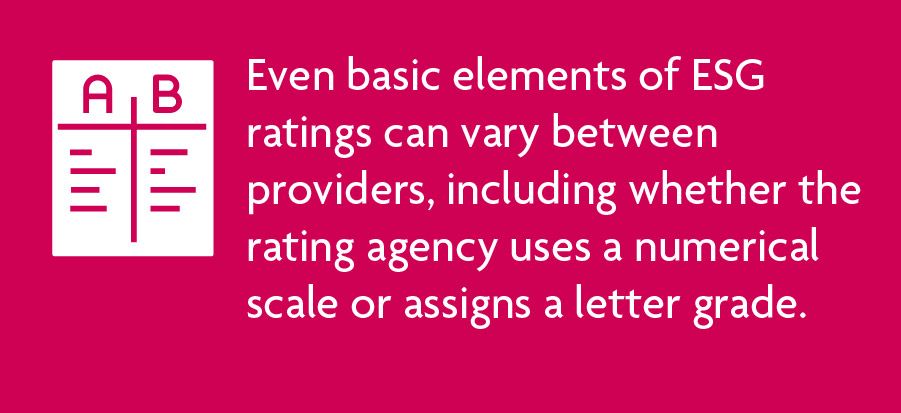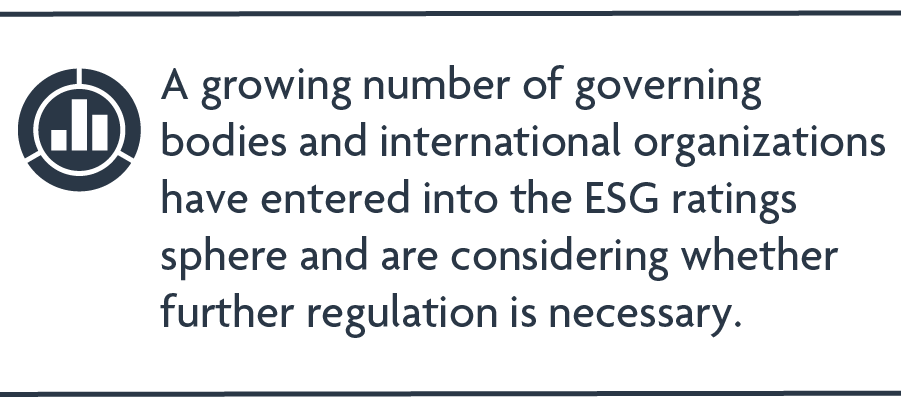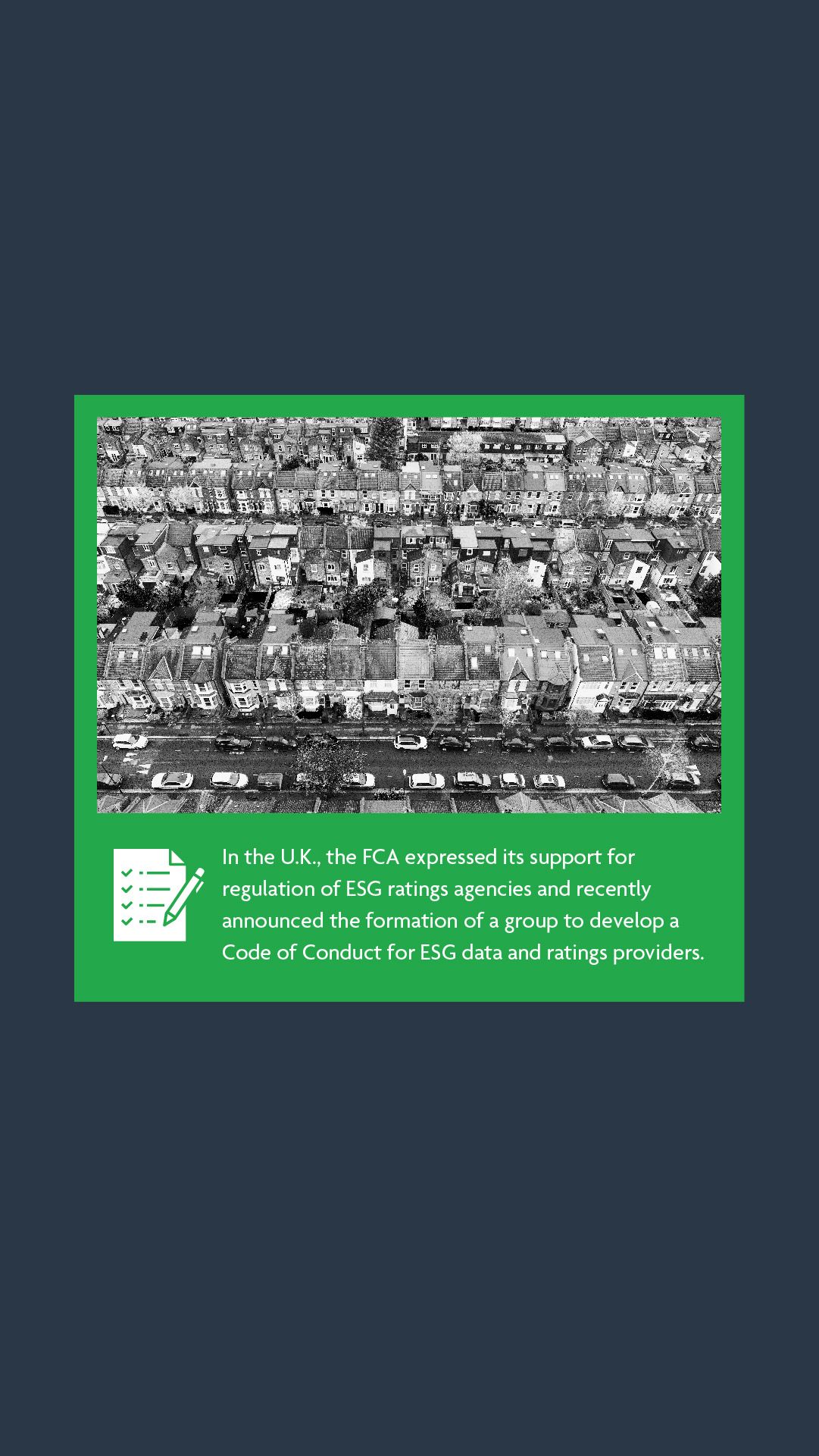ESG ratings:
An update

ESG ratings:
An update

As ESG financial products and metrics increase in the market, so too does the demand for comparability, transparency and oversight. ESG ratings have the potential to meet that demand, but come with their own set of challenges. ESG rating agencies and/or services, which operate similarly to credit rating services, create independent reports on ESG opportunities and risks facing a company or a product, ostensibly allowing that company, its stakeholders and investors to better understand ESG elements, risks or impacts – whether negative or positive. Yet discrepancies among rating systems; aggregated “E,” “S,” and “G” calculations; and differing methodologies and data bring a lack of clarity to the ESG rating market.

The ESG rating industry is largely self-policed and unregulated. Services develop proprietary methodologies, which creates incomparable results and fuels a general debate regarding the usefulness of the ESG rating system altogether. Even basic elements of ESG ratings can vary between providers, including whether the rating agency uses a numerical scale (e.g., 98 out of 100) or assigns a letter grade. In response to market confusion and a lack of comparable metrics, many have called for transparency, disclosure requirements and standardization. In fact, the International Financial Reporting Standards Foundation (IFRS) created the International Sustainability Standards Board (ISSB) in November 2021 to address that very issue and released a proposed standard for General Sustainability-Related Disclosures in March 20221.
As consumers of ESG rating services work to understand the system, companies also face concurrent, mounting pressure to ensure all ESG statements, actions and marketing efforts are clear and accurate. Errors or misstatements regarding a company’s ESG metrics, advancements and goals will increasingly be subject to scrutiny by investors, the public and regulators.



The ESG rating industry is largely self-policed and unregulated. Services develop proprietary methodologies, which creates incomparable results and fuels a general debate regarding the usefulness of the ESG rating system altogether. Even basic elements of ESG ratings can vary between providers, including whether the rating agency uses a numerical scale (e.g., 98 out of 100) or assigns a letter grade. In response to market confusion and a lack of comparable metrics, many have called for transparency, disclosure requirements and standardization. In fact, the International Financial Reporting Standards Foundation (IFRS) created the International Sustainability Standards Board (ISSB) in November 2021 to address that very issue and released a proposed standard for General Sustainability-Related Disclosures in March 20221.

As consumers of ESG rating services work to understand the system, companies also face concurrent, mounting pressure to ensure all ESG statements, actions and marketing efforts are clear and accurate. Errors or misstatements regarding a company’s ESG metrics, advancements and goals will increasingly be subject to scrutiny by investors, the public and regulators.

A growing number of governing bodies and international organizations have entered into the ESG ratings sphere and are considering whether further regulation is necessary. The International Organization of Securities Commission (IOSCO) published a November 2021 report that included recommendations for ESG product ratings and identified that “there is little clarity and alignment on definitions, including on what ratings or data products intend to measure” and that there is “a lack of transparency about these methodologies underpinning these ratings”2. The Securities and Exchange Board of India (SEBI) announced in January 2022 that it would begin to regulate ESG ratings, thereby becoming the first country to do so. SEBI’s regulatory framework includes SEBI accreditation of ratings providers, but does not go so far as to propose a standardized ratings measurement. Japan recently took action as well, through its draft Code of Conduct for ESG Evaluation and Data Providers3, and financial regulators across Africa are beginning to incorporate ESG factors into state-sponsored investment programs4.
A growing number of governing bodies and international organizations have entered into the ESG ratings sphere and are considering whether further regulation is necessary. The International Organization of Securities Commission (IOSCO) published a November 2021 report that included recommendations for ESG product ratings and identified that “there is little clarity and alignment on definitions, including on what ratings or data products intend to measure” and that there is “a lack of transparency about these methodologies underpinning these ratings”2. The Securities and Exchange Board of India (SEBI) announced in January 2022 that it would begin to regulate ESG ratings, thereby becoming the first country to do so. SEBI’s regulatory framework includes SEBI accreditation of ratings providers, but does not go so far as to propose a standardized ratings measurement. Japan recently took action as well, through its draft Code of Conduct for ESG Evaluation and Data Providers3, and financial regulators across Africa are beginning to incorporate ESG factors into state-sponsored investment programs4.

In the United Kingdom (U.K.), the Financial Conduct Authority (FCA) expressed its support for regulation of ESG ratings agencies and recently announced the formation of a group to develop a Code of Conduct for ESG data and ratings providers5. In a step toward standardization, the FCA will “coordinat[e] as far as possible with other jurisdictions” in the development of any regulatory approach6. The international Taskforce on Climate-related Financial Disclosures (TCFD) has been adding to the developing set of available guidance as well, including its most recent Status Report that provides an overview of current disclosure practices and reports key themes and findings from the Taskforce’s disclosure review7.


In the United Kingdom (U.K.), the Financial Conduct Authority (FCA) expressed its support for regulation of ESG ratings agencies and recently announced the formation of a group to develop a Code of Conduct for ESG data and ratings providers5. In a step toward standardization, the FCA will “coordinat[e] as far as possible with other jurisdictions” in the development of any regulatory approach6. The international Taskforce on Climate-related Financial Disclosures (TCFD) has been adding to the developing set of available guidance as well, including its most recent Status Report that provides an overview of current disclosure practices and reports key themes and findings from the Taskforce’s disclosure review7.
Most recently, the SEC proposed a rule in May 2022 to enhance and standardize disclosures related to ESG factors considered by funds and advisers, and to expand the regulation of the naming of funds with an ESG focus8. The SEC is currently considering public comments on its proposed ESG disclosure rules (the public comment period closed November 1, 2022), and the agency will likely implement the disclosure rule, or a version of it, in 2023.
The status quo places the onus on those relying on third-party ESG rating providers to complete proper due diligence. Even after due diligence, however, the lack of standardized ratings criteria leaves companies with questions about the reliability of the ratings and rating systems themselves. To ensure reliability, some investors and companies choose to conduct their own assessment and analysis of ESG data. Those that use third-party ESG ratings providers would be well advised to take time to understand the data and methodology the provider uses, both at the outset of the process and regularly while the ESG rating is used. Taking either, or both, of these approaches will provide a greater level of protection and assurance that their ESG rating is defensible.


Most recently, the SEC proposed a rule in May 2022 to enhance and standardize disclosures related to ESG factors considered by funds and advisers, and to expand the regulation of the naming of funds with an ESG focus8. The SEC is currently considering public comments on its proposed ESG disclosure rules (the public comment period closed November 1, 2022), and the agency will likely implement the disclosure rule, or a version of it, in 2023.
The status quo places the onus on those relying on third-party ESG rating providers to complete proper due diligence. Even after due diligence, however, the lack of standardized ratings criteria leaves companies with questions about the reliability of the ratings and rating systems themselves. To ensure reliability, some investors and companies choose to conduct their own assessment and analysis of ESG data. Those that use third-party ESG ratings providers would be well advised to take time to understand the data and methodology the provider uses, both at the outset of the process and regularly while the ESG rating is used. Taking either, or both, of these approaches will provide a greater level of protection and assurance that their ESG rating is defensible.
Authors
Amy Kennedy
Partner
amy.kennedy@akingump.com
London
T+44 20.7012.9868
F+44 20.7012.9601
v-card
Stacey H. Mitchell
Partner
shmitchell@akingump.com
Washington, D.C.
T+1 202.887.4338
v-card





